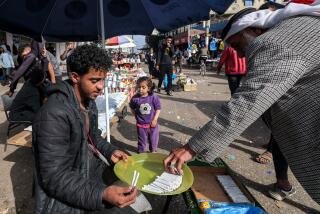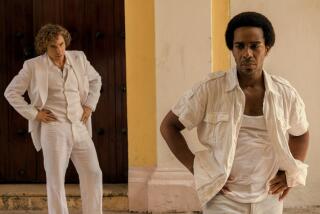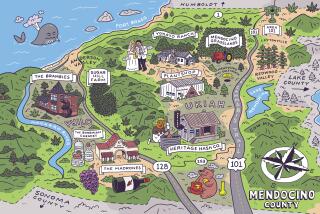On a Roll : Cigar Maker Fashions 400 or So a Day With Tender Care
On the wall just inside the door of Pablo Friasâ tiny shop is a photograph of a stooped, white-haired woman glowering over a huge cigar that dangles with casual familiarity from her mouth. She looks to be in her 90s--and was at the time the picture was taken.
âMy mother,â says Frias proudly. âShe teach my brothers to smoke cigars. My five sisters, they smoke, too. She die a year ago, but not from smoking cigars, just from old.â
Frias, whose heavy accent is Cuban, takes a tightly rolled corona out of his mouth and smiles, pleased not only at the memory of his youth and apprenticeship in Cuba, but at the taste of his own handiwork. He made the cigar.
By the end of the day, he will have made perhaps 400 of them. Individually, by hand.
Frias, 53, is the only cigar maker in Orange County and one of only a few in the United States, and, by any yardstick, he is a veteran at his trade. He says he began to learn the craft of rolling tobacco into different shapes and lengths when he was 7 years old and living near Havana. Tobacco grew everywhere. His two brothers became planters. And early on, Frias said, he came to know different tobaccos by look, feel, smell and taste.
Frias left Havana in 1955 and moved to Miami. In late 1972, he moved to Santa Ana and set up shop, naming his business the Teri Cigar Co. after his daughter.
Since then, he said, he has found buyers for his cigars throughout the country. A handful of retail tobacconists in Orange County carry his cigars, including the tobacco shop at Disneyland.
âWe order quite regularly from him, and weâve done a pretty good business with the cigars,â said Linda Votaw, Disneylandâs buyer for tobacco and candy. âWe usually deal with distributors and large companies, so itâs rare to find a small operation like he has. People are surprised when they see his brand of cigar in the shop.â
Laguna Customer
One of Friasâ oldest Southern California customers is Phil Guy, owner of the Laguna Beach Pipe & Tobacco Shop.
âHis cigars are very good sellers,â Guy said. âIâve stocked them for about 15 years. He uses a good combination of tobaccos, a good blend. Theyâre mild, but theyâre full-bodied and very pleasing to the taste. Theyâre quite popular.â
Frias manages to make it look easy. After selecting the proper blend of tobaccos from several boxes and bales in the back of his shop, he fits them into one of many dozens of well-worn wooden molds and clamps the molds for several minutes into a press. He then sits at a small table, selects and deftly cuts the soft wrapper leaf with a handle-less blade, rolls the leaf tightly around the molded tobacco, forms a closed end with special paste and sharply snips the open end flat with a second small blade.
Four hundred times a day.
The Teri Cigar Co. is anything but fancy, but Frias said it attracts a devoted neighborhood clientele, as well as âa lot of the lawyersâ from the nearby county courthouse. While the furnishings are spare, itâs the heady smell of the place that sets the mind to rhapsodizing.
Franz Liszt swirling brandy in a snifter. Mark Twain in a white linen suit. Georgian parlors. Elegant Victorian Pullman cars. Winston Churchill, jaw jutting through a redolent haze of blue smoke. Groucho Marx.
Customer of Himself
And Pablo Frias. The cigar maker also is one of his own best customers.
âI smoke a lot of cigars to see if taste is good,â he says. âNot too sweet. Lot of my customers like sweet, but I like a little bit strong, a lot of flavor. With the tobacco, the more old, the more better, like wine. You smoke 11, 12 a day, you feel good.â
Frias refuses to believe that cigar smoking could be harmful, calling such talk âpropaganda.â It is, he claims, the non-tobacco filler in many cigars and what he calls âthe chemicalsâ that do the damage. He says he puts nothing into his cigars but well-aged, pure tobacco.
âThere are no chemicals or fillers in his cigars,â Guy agreed. âWith a cigar, thereâs nothing to keep it lit, you have to keep puffing on it. And you generally donât inhale it, you taste it. Itâs delightful, like a brandy after a good dinner.â
Also, Guy said, among smokers, cigars seem to be enjoying a gradual rise in popularity over cigarettes. They are, he said, a healthier alternative.
(Cigars indeed are less damaging to health than cigarettes, according to an American Cancer Society study, but a U.S. Department of Agriculture report shows that cigar smoking in America has decreased sharply in the last 25 years. The cancer society study, published in 1982, found that while the risk of getting any form of cancer is twice as high for cigarette smokers as for non-smokers, that risk goes up by only a third for cigar smokers. The Department of Agriculture report stated, however, that cigars smoked per capita each year in the United States decreased from 60.7 in 1960 to 18.1 in 1985.)
Sources of Tobacco
Frias said his best stock comes from the Dominican Republic and Honduras. Cuban tobacco, like all Cuban goods, continues to be contraband, but Frias said he doesnât long for it.
His sources are âmucho better than Cuban tobacco now. I have customers who go to Europe, smoke Havanas and say, âPablo, yours are better.â â
And, he adds, while his customers pay from 60 cents to $1.50 for his standard cigar types, he can, and does, roll individual blends by request.
Frias says he knows he is a vanishing breed.
âThe young people want to go to school today,â he said, âthey donât want to make cigars. In Cuba, yes, but not here. But I am happy. I am happy because I make my customers happy. My customers, they are like family. For me, this is the best job.â


